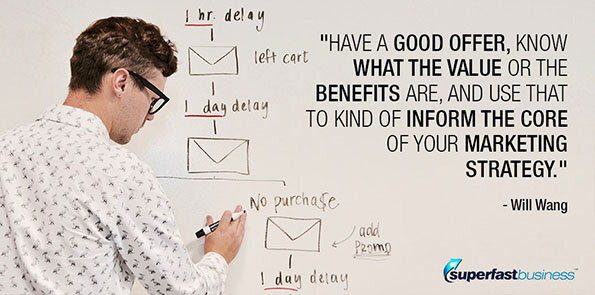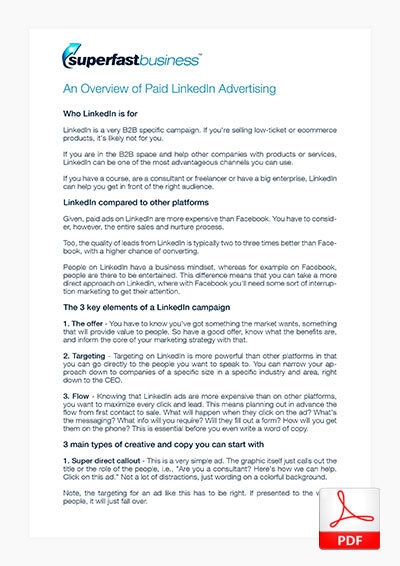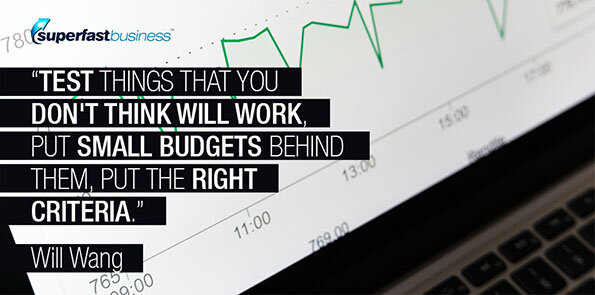Paid online advertising quickly brings to mind Facebook and Google. Paid ads on LinkedIn? A much less-known entity.
Regular Will Wang from Growth Labz returns to the show to educate us on paid LinkedIn ads. We break down who they’re for, what makes them work, and how to start an effective campaign.
Podcast: Download (Duration: 20:37 — 19.0MB)
Get Notified Of Future Episodes Apple Podcasts | Spotify | Amazon Music | Android | Blubrry | Gaana | TuneIn | Deezer | Anghami | RSS | More
Podcast topics:
01:29 – Are paid LinkedIn campaigns right for you?
03:22 – The current state of LinkedIn ads
04:44 – Business types that the channel works for
06:13 – How the Linkedin pathway differs from other platforms
08:07 – A place for a more direct approach
09:45 – Three key elements of a LinkedIn campaign
12:06 – How long before you achieve ROI?
12:53 – What exactly goes into the ads
15:55 – Quality leads for less cost
17:35 – One final pointer
18:43 – Speed up your results
James coaches online business owners from four figures a year to eight figures a year. (Including Will Wang). Perhaps it’s time for you to get access to expert business coaching inside SuperFastBusiness (membership).
Transcription:
James: James Schramko here. Welcome back to SuperFastBusiness.com. This is Episode 776. I’m chatting to my good friend Will Wang. Welcome back.
Will: Thanks for having me back, James.
James: You’re always on this podcast, Will. You’ve got a popular audience now, I think, with the SuperFastBusiness crowd, because you always deliver really interesting topics. So thank you for your continued dedication to our paid traffic education.
And today, you’re going to be talking about LinkedIn ads. So I’m really curious about this, because you’ve been on previous episodes talking about cold approaches. I know you’re a huge advocate of LinkedIn, in a business strategy for the right business.
Who LinkedIn campaigns are ideally for
Why don’t we just set the scene here? Who is going to be using LinkedIn, firstly, and secondly, who’s going to be using it for organic type campaigns versus cold outreach campaigns versus paid campaigns? Give us a little bit of a view on this.
Will: Yeah, that’s a great question, James. With LinkedIn, it is a little bit of a different platform. It’s a very B2B specific platform. So if you’re selling low-ticket B2C stuff, ecommerce stuff, probably not the best play for you.
That being said, you know, if you are in the B2B space, and you help other businesses with services or products, LinkedIn in one form or another could be the best platform, or one of the strongest strategies that you can use or channels you can use in your marketing mix.
So the way that I look at it is, if you’ve got a course you can do, if you’re a consultant, a freelancer, or even a really big enterprise, you know, we work with clients from all across the gamut, from startups all the way to massive funded beasts of companies. And they all use LinkedIn in one way or another to kind of get in front of the right audience.
So as you were saying, there’s so many different ways to approach it. If you’re low on budget, you can use LinkedIn to approach or to do a really good cold approach to people to start conversations. If you have a bit more of a budget, and if you want it to be a little more leveraged, you can use it to run advertising similar to other networks like Facebook, or also Google ads.
James: We don’t hear much about LinkedIn paid ads. I know I’ve dabbled with it before when I had the SEO business. I’m probably talking 7 years ago, whenever the platform started with ads, I think I was on it, then. It wasn’t very effective for me. But that being said, I may not have been effective at advertising. At the time, it seemed like I was paying a lot and I wasn’t getting many bites.
Certainly lately in my business with the coaching side of things and information products, LinkedIn has been great for us when we publish short videos, and we educate people. And we’ve been able to build up connections. I still get a lot of people trying to connect with me and just cold pitch me stuff the wrong way. And that’s a bit annoying.
The current state of LinkedIn ads
But let’s talk about LinkedIn ads. Do they work now? And are they still expensive? Or has that changed?
Will: Yeah. So with the numbers that we’re seeing, and now I’m in a pretty fortunate position where I get to work across different accounts, and you know, we’ve some fairly big budgets every now and again. So I do get to see some of the numbers on the back end.
And LinkedIn was one of those platforms which spiked a lot. So some months, it would be great, some months, not so much. When it got bought by Microsoft, the data kind of went haywire and things stopped working for a little bit. But overall, across the accounts that we’re managing, I’m still seeing some really good results in the conversion and lead quality.
Now, upfront, clicks on LinkedIn going through, it’s going to look like it’s actually more expensive than something like Facebook. But you’ve got to also take into account the entire sales process and also nurture process.
Now what we see is the leads from LinkedIn are typically in terms of quality-wise, two to three times better than from Facebook, for example. So it might be paying a little bit more for the leads, but they’ve got a bigger chance of converting. And that’s, you know, how we kind of track the sales process and sales cycle.
And if you know that you can pay less for a conversion to a customer, well, in that case, it makes a lot more sense. So it definitely does work now. You’ve just got to test a lot. It’s a different mentality coming into LinkedIn ads, versus something that’s more established, like a Facebook or a Google platform.
Business types that the channel works for
James: So it sounds like it’s a little more high-end program for serious players. Could you give me sort of an example of the type of business? You don’t have to name names. Of course you can’t, with being an agency anyway. But who do LinkedIn ads actually work for? Like, what type? Are we talking about service businesses, or some other kind of business?
Will: Yeah, so service and product businesses both, and we’ve seen some pretty good success. So, for example, one of our clients sells courses to other entrepreneurs, to other business owners. And they’ve used LinkedIn ads to get in front of the right audience in a more effective way than in Facebook.
So what we’ve actually found was, in terms of Facebook advertising, they were paying around $200 to acquire a new customer. But that customer wouldn’t necessarily go on and actually buy more products. So the lifetime value of a customer was, you know, around $250 or so.
Now, we went to LinkedIn and ran a similar kind of campaign, obviously a little bit different, because you’re going to adjust it to the platform. But we were able to acquire customers for about $300 to $350. So on the front end, it actually looked like it was more expensive. But those customers that came through had bigger budgets. The lifetime value was actually a lot more than with Facebook customers. So that’s one example of a product being sold on LinkedIn.
James: And what type of businesses are they selling the courses to?
Will: They’re selling it to freelancers, and also consultants. So freelancers, coaches, consultants.
James: And what sort of price points are we talking about?
Will: It’s a range of products. So starting from $200 all the way up to about $7,000, or $10,000, on the high end. So they’ve got a really good process in the back end. But you know, in acquisition, it was a $200 product.
The Linkedin pathway versus other platforms
James: And have you found any differences between LinkedIn and other platforms, where you might have a different pathway? For example, on Facebook, it’s typical that people lead to something that ends up in an application call, that then gets sold over the phone. Are you finding with LinkedIn, for example, that you might be able to go directly to a high-ticket order without the application step? I’m just being a bit creative here.
Will: Yeah, you definitely can. So one of our clients is actually a big player in the software space. So they’re a B2B software provider, financial software provider, let’s just say. And what they do is, obviously there’s no products that they can sell on the front end, because it’s all about how their service really helps the business owners and the businesses.
So with them, we go through, and we have a process of getting them straight on to, it’s more application form, that the salesman then takes and actually, you know, does the sales process with. So you definitely can go from ad spread to application on LinkedIn. And I almost think that it’s easier doing it that way, rather than using Facebook and trying the same funnel via Facebook.
James: Nice. Okay. So you talked about a change in mindset. I guess, like, we probably want to clean sheet this and forget what we know about other platforms and how we’ve been running our ads. How would we approach this from the start?
Will: Yep, so I’ve looked at it, like, looking at the audience on LinkedIn, who’s using LinkedIn, why are they on LinkedIn? And it kind of gives you a different picture. So if people are on LinkedIn, they’ve more or less, they’re professionals, they’ve got a business, they run the platform to either learn or to network and grow their businesses.
So for me, if they’re on there with a serious intention of growing their businesses and learning and growing their networks, potentially finding jobs, it’s so much easier to go through to them with a direct message that talks about the benefits. So whereas on Facebook, people are kind of browsing cat photos and dog pictures, and you’ve got to really tell the story and suck them in and really try to break down their defenses or try to get around their defenses.
A place for a more direct approach
On LinkedIn, people understand that it’s a platform to do business on. So it’s actually a lot better just to go direct, rather than trying to tell this big, huge, long personal story. And you can actually go direct and speak about what you help them with.
“Linkedin is for business.”
James: Right. So in summary, people go onto Facebook to be entertained, and you need interruption marketing to move them back onto the business track, whereas they’re already at that point, when they start on LinkedIn, they’re on there for business.
And it’s nice to hear that there’s people on LinkedIn who aren’t just there to sell something to you in your inbox. I do know, lots of professionals get jobs and also find the right key relationships on LinkedIn. So it seems to be getting better at that.
So skip step one, the interruption decoy. Now, just go straight to the direct talk. Now that you say that, and I’ve never thought about this before, Will, I suspect this is why LinkedIn works well for me. Because I usually get straight to the point, and I’m very direct in business, even on my Facebook.
It makes me think for Facebook, I need to put a step in front of whatever I do to make it more effective. But LinkedIn has been good for us because we’re just straight into the meat and potatoes.
Will: Yeah, exactly. There’s no need to wrap your offer in a story about how you were broke and living on a friend’s couch.
James: I’ve never really been broke, so that’s a fail. And I really don’t like sleeping on other people’s couches. I always prefer to find my own accommodation if possible.
So you’re talking about the offer, and you’re going direct now, like, straight up, what do they actually want, hit them between the eyeballs. I don’t know how the platform works in terms of targeting, but I imagine you’ve got some kind of choice there. It’s not a run of network.
Three key elements of a LinkedIn campaign
Will: Yeah, exactly. So I mean, I guess at this stage, it’s probably good to go into the three key things that we look at when we put together campaigns and when we plan it.
The number one thing, as you said, was definitely the offer. So knowing that you’ve got something the market wants, knowing that you’ve got something that’s going to provide value to people, that’s key. If someone doesn’t want or the market doesn’t want what you’re trying to sell, there’s no amount of good marketing that you can do to kind of reverse that.
 So number one is offer. And that kind of takes it beyond the LinkedIn channel or platform. So we might just say, have a good offer, know what the value or the benefits are, and use that to kind of inform the core of your marketing strategy.
So number one is offer. And that kind of takes it beyond the LinkedIn channel or platform. So we might just say, have a good offer, know what the value or the benefits are, and use that to kind of inform the core of your marketing strategy.
Number two is targeting. And targeting on LinkedIn, for me, from a B2B perspective, is so much more powerful than Facebook, because we can go directly to the right people that we want to speak to.
On Facebook, if I want to target CEOs of companies, I’ve got to do all these tricky stuff in the back end, look at all these different targeting interests, you know, mixing and matching. And a lot of the times, it’s very miss rather than hit. Whereas on LinkedIn, I can actually go to LinkedIn and say, Look, I want to target companies of this size in this industry in this area. And I only want to show the ads to the CEO, for example.
So you can get so specific, and LinkedIn is just this goldmine of good data that you can use to both do the outreach, and also the same fields, and you know, the same data source is available to you for advertising. So it’s just this extremely powerful network.
We’ve tested a whole bunch of things in terms of targeting on LinkedIn as well. And by and large, the one placement that’s working now – so placement is where your ads get shown – is on that newsfeed. So if you get the right targeting, show the ads in a very obvious way in the newsfeed, chances are, you’re going to be getting in front of your ideal audience.
James: Nice. Okay. And then what?
“LinkedIn as a front end channel is expensive, so maximize every single click and lead.”
Will: Yep. And so we then plan out what actually happens after. Now, given that LinkedIn as a front end channel is so much more expensive, you know, it can be a lot more expensive than other platforms, you really want to maximize every single click and every single lead.
So before we build a single ad, or write a single word of copy, we look at what the flow is for the lead coming through. So once they click on the ad, what happens? What’s the messaging? From that point, what do they do? Do we ask them for information, like a name and email? Do we ask them to fill out a form? What actually happens afterwards?
And then once I’ve done that, how do we get them on to a phone call? Is it a sequence of emails that we send them? Do we just pick up the phone and call them? Planning out the actual flow and sales flow and user flow is actually super important, just because, you know, it’s a little bit more expensive to get in front of these people.
How long before you achieve ROI?
James: How long would you track a campaign through to the end to determine that lifetime value? Because I suspect there might be a long cycle for some of these campaigns. And people might call it too early, like they want to get their money back tomorrow, but it might take a month or two months.
Will: So typically, we look at attribution over a 28-day period. So when someone sees adding clicks on the ad, what happens over the next 28 days? Now, obviously, you know, that’s not the period that you should be aiming for. We want to get a return on investment as quickly as possible.
So if we can get it within seven days, awesome. But there is, especially with some bigger deal sizes and some higher value products, no one’s going to turn around and give you $10,000. Well, very rarely would they turn around and give you $10,000, just because they saw your ad. It does take a bit of nurturing, warming up and also sales.
James: Nice.
What exactly goes into the ads
So can we talk about what you actually put in the ads? Because that’s going to be the first place, we’re sitting there with a blank screen, or canvas. And we have to figure out what the creative is going to look like.
Will: Yep, so I’ll give the listeners kind of the three main types of creative and copy that we’re using at the moment. We’re testing thousands of combinations every single month, but these are the core three that we start our test with. And if they don’t work, we move on to something else.
But the number one thing we’re testing at the moment, and, you know, I’ll put my hand up to be honest and say that I didn’t think this would work. And this was something that I learned from a client of mine.
James: Often the way with the test, isn’t it?
Will: Yeah, exactly. So the first one is actually a super direct callout, a super simple ad. The graphic itself just calls out the title or the role of the people. So for example, an ad might be like, Are you a consultant? And it’s only in graphical form, not a lot of distractions on it. And it’s just wording on a colorful background.
And the way that we kind of discovered this was, I was running a campaign for a client of mine. And we were doing animations and flashy videos and things like that. And they said, Look, a competitor of ours based in another country is actually running this type of ads, can you test it?
And initially, I thought, No, it’s too simple. No one’s going to look at it, it’s not going to work. But in the interest of testing and learning, I said, it’s fine. Why don’t we just do a few like this and test it? And by far and large, those ads actually worked better than everything else. And it really caught me by surprise.
But we’ve tested this across a couple of accounts now in a couple of campaigns, and it’s actually consistently performed. So you know, completely surprised by it, but it kind of makes sense, because people are more direct on LinkedIn.
So the first type of ad will be this super direct call out: Are you a CEO? Are you a consultant? Here’s how we can help. Click on this ad.
James: I think this speaks a lot to the targeting, too, you know? I think the most effective ad I’ve seen on Facebook ever would be Sam Ovens’s ad that just says ad. And in the copy it says, Look, hopefully, I’ve got my targeting right, and you’re this type of person, etc, and it explains the offer. And all the comments are praise for the ad, it really hit the sweet spot by being super direct, clear and simple.
“Linkedin targeting has to be right.”
But the targeting has to be right. If you’re targeting the wrong people, it’s going to fall over. But targeting people like you and I, it’s very effective. Because, you know, we’re so sick of people trying to trick us. It’s nice that someone’s refreshingly straight up and blunt.
Will: Yeah, definitely. So yeah, I mean, you do have to make sure that you’ve got the right targeting.
James: Yeah.
Will: It’s the number one thing. Yeah.
James: So what other kind of ads can we do?
Will: Yep. So the second one is looking at video and also animation ads. As you were saying previously, on LinkedIn, you’re finding videos work really, really well.
James: Oh, yeah.
Will: And that’s the same when it comes to ads.
James: Because it’s so boring on LinkedIn. LinkedIn’s boring. And videos pop through.
 Will: Exactly. And it’s the same with advertising. I mean, if you’re showing the ads in their newsfeed, it’s the exact same principle that it’s going to get their attention. LinkedIn is very dry, you don’t get a lot of room to write really long-form copy and really fun ads. So people kind of scroll through, and unless something really captures their attention, they just kind of keep scrolling.
Will: Exactly. And it’s the same with advertising. I mean, if you’re showing the ads in their newsfeed, it’s the exact same principle that it’s going to get their attention. LinkedIn is very dry, you don’t get a lot of room to write really long-form copy and really fun ads. So people kind of scroll through, and unless something really captures their attention, they just kind of keep scrolling.
So that’s why you know, video works so well. And again, organic ads, we’ve found, it works super well across both.
James: Nice.
Okay, what else have we got?
Quality leads for less cost
Will: Yup, and the third one, it isn’t really ad creative or ad copy. But I wanted to bring it up, because it is quite important. And it’s a lead form ad. So if you’ve done a lot of Facebook advertising in the past, you might be familiar with lead forms that Facebook has. It’s where they click on the ad, a form loads of all the details from the account, and it gets shot off to you.
The problem with Facebook lead forms, even LinkedIn lead forms, are that sometimes when you call the leads, they don’t know who you are, or how you’ve got their details. Because it’s such an easy process. Now, lead form ads on LinkedIn is actually one of the cheapest ways of getting really good leads through. And typically, the lead forms themselves are much better quality leads than Facebook.
But we still, every so often, get people being like, Whoa, who are you? How did you get my details? So one of the things that we do is we actually change the lead form itself, and put a customized question on there where they have to type in the answer. So that gives people to actually understand, hey, I’m submitting some information to you. It puts a barrier to entry.
So we filter out people who are just looking for freebies, who click accidentally because they don’t know what they’re doing on the platform. And that increases the lead quality, but not the lead cost substantially. So it’s not so much creative or copy, but it’s just how we use the platform and the type of ads that we do show.
James: When I started asking a couple of questions on my homepage, it lifted my opt ins by about 15 percent. So I wonder if asking people to type in a question gives them some kind of investment in it, and makes it more relevant for them?
Will: And it just makes it more real. It’s not just, you know, I click two buttons and I get all my information sent to some random marketer. Now I’ve got to think about why I’m submitting this information.
James: Right. So what else do we need to know if we’re going to take this on?
One final pointer
Will: The final point I would say is test, test, test. So the LinkedIn ads algorithm isn’t nearly as mature as Facebook or Google. They’re a late player for the game. So the algorithm and the data behind advertising isn’t quite as strong, which is a good thing and a bad thing. So what I would say is, you know, test things that you don’t think will work, put small budgets behind them, put the right criteria.
And just, you know, instead of the AI doing the learning, or the advertising for you, you’ve got to be more manual and be more methodical and think for a little bit more. But if you can do that, the results are, for businesses, it’s such a goldmine of data in targeting. So I highly recommend people jump on it and test it out and make sure that they do test targeting, ads, creative, all of that kind of stuff.
James: It’s good. I mean, it’s just refreshing to speak to someone who’s actually doing this, because I don’t hear much about LinkedIn ads. I’ve heard whispers in the corridors, that’s virtual corridors – about it. But it’s not a mainstream thing. It’s like I very rarely hear anyone talking about Amazon advertising. Facebook’s dominating the conversation, YouTube’s coming up second, and Google’s always been a powerhouse. But LinkedIn is right there for the right type of business.
Where to get an assist
If someone’s listening to this, and they’re not sure if it’s right for them, is there any chance they could get in touch with you? Or do you help people do this in any way?
Will: Yeah, definitely. So we’ve actually come up with, you know, with your help and support, we’ve come up with a new program where it’s like a done-with-you program, where we actually help them get advertising set up, outreach set up, and just build a lead generation machine into their businesses.
So if they’re wanting to find more information about that, my contact is [email protected]. So they can just reach out and you know, I’m happy to talk to them about their lead generation, their marketing, and figure out how they can make this all work for their business.
James: Nice. Thank you so much for another installment, you helping us get leads, get more customers. You’re a champion of multiple disciplines, some of that martial arts experience is shining through there, Will.
Will: Thanks, James. Always fun to be on here.
James: There you go. That’s Will Wang from GrowthLabz.com. He’s one of my fabulous friends. He’s a local, we hang out in real life sometimes. And we’re also partners in growing his agency, because he’s doing good stuff, and I just love it. It’s so exciting hearing what you’ve got, I’d love you to come back and share some other stuff with us in the future.
So if you’re listening to this episode, which is episode number 776, you can get the transcription of it. We’ll put links to Will, you can get in touch with him if you got any questions about it or you want some help with your LinkedIn ads.
And also, we take suggestions for future episodes, questions, topic ideas. Put Will to the challenge. See if you can get him to spill the beans on his next things. He’s always got so many great insights, check out the previous episodes I’ve recorded with Will, because they’re still super valuable. Until next time, Will.
Will: Thanks again, James.
Need high-quality leads for your business? Contact Will and his team at GrowthLabz.com
Liked the show? Leave us a review on iTunes











Leave a Reply